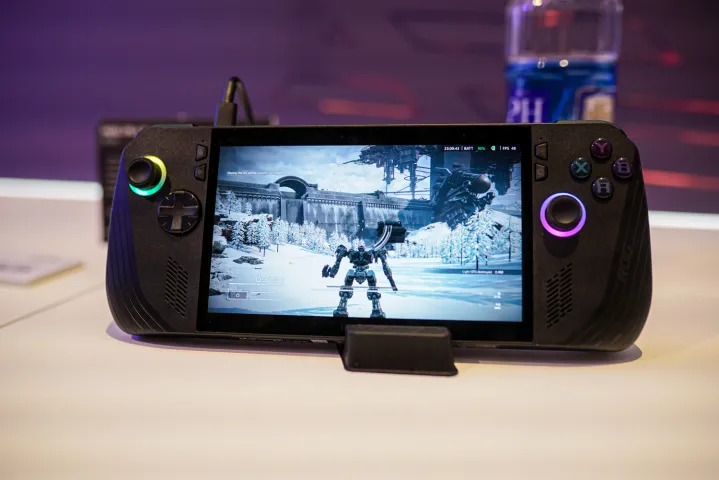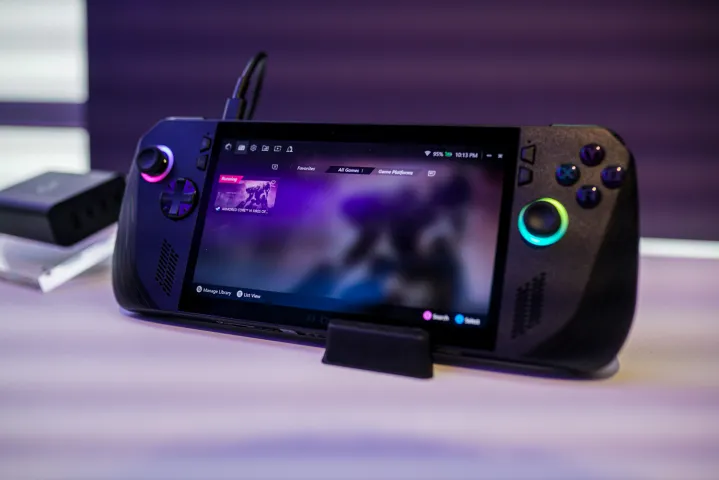

This story is part of our coverage of Computex, the world's biggest computing conference.
It’s not much of an overstatement to say that when Valve released the original Steam Deck, it started a real handheld PC revolution. Launching the Steam Deck OLED only emphasized that while there may be other, more powerful consoles on the market now, Valve’s offering still stands strong against the competition. But can it hold its ground against the Asus ROG Ally X?
Contents
- Specs
- Pricing and availability
- Design and battery
- Performance
- A matter of choice
The two handhelds have more in common than it might seem at first glance. While both are a refresh, neither is a full-blown version 2.0. How do they stack up against each other, though? Read our comparison to find out which device wins in a battle of Asus ROG Ally X vs. Steam Deck OLED.
Recommended Videos
Specs
| Steam Deck OLED | Asus ROG Ally X | |
| APU | AMD custom APU: 6nm, 4 cores/8 threads, up to 3.5GHz | AMD Ryzen Z1 Extreme: 4nm, 8 cores/16 threads, up to 5.1GHz |
| Memory | 16GB LPDDR5-6400 | 24GB LPDDR5-7500 |
| Storage | up to 1TB NVMe SSD | up to 1TB M.2 2280 NVMe PCIe Gen 4 SSD |
| Screen | 7.4-inch 1,280 x 800 HDR OLED, 90Hz | 7-inch 1,920 x 1,080 IPS, 120Hz |
| Ports | 1x USB-C, 1x microSD slot, 1x 3.5mm audio | 1x USB-C (USB 3.2 Gen 2 and DP 1.4), 1x USB 4, 1x 3.5mm audio, 1x microSD slot |
| Battery capacity | 50Wh | 80Wh |
| Dimensions (LxWxH) | 11.73 x 4.6 x 1.93 inches | 11.02 x 4.37 x 0.97 inches |
| Weight | 1.40 pounds (635 grams) | 1.49 pounds (675 grams) |
| Price | $550/$650 | $800 |
Related
- Asus is axing one major feature with the ROG Ally X
- You might not be able to afford the ROG Ally X
- The Asus ROG Ally just got a game-changing update
Comparing the specs of the two handhelds immediately puts the Asus ROG Ally X at an advantage — but that’s not much different from comparing the base Steam Deck to the ROG Ally Z1 Extreme. Chiefly thanks to the improved APU, the ROG Ally X is bound to have an edge here.
The AMD Ryzen Z1 Extreme chip ended up in more than one portable mini PC, while the Steam Deck has its own custom AMD APU. However, the former is significantly better; built on a more advanced 4nm process, it sports twice the cores and threads as well as a higher maximum clock speed. The differences don’t end there.
The new ROG Ally X received a RAM upgrade compared to its predecessor, putting it further ahead of the Steam Deck OLED. Not only does it have 8GB more memory, but the RAM is also faster, and as this is on-board memory, it can be split between the system and the GPU as needed. Moreover, Asus gave the ROG Ally X a more upgradeable M.2 2280 NVMe SSD.
In terms of hardware, the ROG Ally X largely wins the battle — but the Steam Deck OLED does a good job in other categories.
Pricing and availability

Both the Steam Deck OLED and the Asus ROG Ally X were released as improved versions of their base models. Valve launched the Steam Deck OLED on November 16, 2023, and it adjusted the pricing of the LCD model instead of raising the price. As a result, the 512GB model costs $550, and the 1TB model is priced at $650. The console is readily available for purchase.
Meanwhile, the ROG Ally X was announced during Computex 2024 and is expected to hit the shelves in July 2024. It comes with a price increase compared to its predecessor, though, and will be sold starting at $800 with a standard 1TB of SSD storage.
Design and battery

The two handhelds vary greatly in terms of design. We won’t go over the basic differences between a Steam Deck and an Asus ROG Ally — you can read about those in our comparison of those models. Instead, we’ll discuss the changes that apply only to these newer, updated versions.
For starters, they actually look a little bit more similar now, all thanks to the fact that the ROG Ally X changed its color palette from white to black. Asus also redesigned the joysticks on the ROG Ally X, improved the D-pad, and moved the macro buttons at the back of the console to make them more difficult to hit on accident.
Meanwhile, the Steam Deck served up a massive screen upgrade, going from a slightly dull LCD to a vibrant OLED, and it makes for a stark difference between the two. How will it compare to the ROG Ally X? We haven’t seen the two handhelds side-by-side yet, but the screen on the ROG Ally X is not too shabby, either — it has an IPS panel. However, we expect the Steam Deck to remain superior here, because not only does it have an OLED display but it’s also ever-so-slightly bigger. On the other hand, the Asus gaming device pushes the refresh rates up to 120Hz, while the Steam Deck OLED maxes out at 90Hz.
While Valve was able to shave off a little weight in the OLED model, Asus ended up adding a little bit when it built the ROG Ally X. However, at 0.09 pounds apart, the two are likely to feel practically identical.
The biggest upgrade for the ROG Ally X stems from the fact that Asus doubled the battery capacity, going up from 40Wh to 80Wh. This should have a massive impact on the battery life. While Valve’s battery upgrade is not as significant, the APU was made to be more efficient, which results in a tangible difference in battery life. In our tests, the OLED model consumed about 5% of the battery during a 30-minute gameplay session of Dead Cells. Meanwhile, the non-OLED model would lose at least 10% or less during that same time window.
The difference between the two in this regard boils down to what matters more to you. Steam Deck’s visuals will most likely remain unmatched, but the 80Wh battery on the ROG Ally X takes the crown in that category, too.
Performance

Although the Asus ROG Ally X delivers some upgrades that will have an impact on performance, Asus itself hasn’t shared any benchmarks or predictions. However, we’ve tested the Steam Deck versus the Asus ROG Ally in the past, so we have a good idea of what we’re going to see.
It’s easy to forget that the Asus ROG Ally comes in two versions: one with the Z1 Extreme chip, and one with the non-Extreme APU. The Z1 Extreme version ended up being such an obvious choice that it’s no wonder that Asus only brought back that APU for the new model.
When we tested the ROG Ally Z1 Extreme against the base version of the Steam Deck, we weren’t surprised to find the Asus handheld in the lead by a significant margin across every possible title. Some of the gains were smaller, such as 31 frames per second (fps) for the ROG Ally versus 24 fps for the Steam Deck in Returnal, while some were much more impressive, like 91 fps vs 79 fps in Strange Brigade.
At these lower frame rate thresholds, every frame counts a little bit more, so to see the ROG Ally hit 62 fps inHorizon Zero Dawnor 43 fps inCyberpunk 2077 was impressive. The games were playable on both, but the lead was clear. These tests were carried out at 720p and 800p, respectively. Both handhelds perform worse at higher resolutions.

Valve’s upgrade from the Steam Deck to the OLED version came with some performance improvements, too. Although we’re only talking about a difference of a few frames at most, it can mean a great deal when you’re not already running games at 120 fps. At the Steam Deck’s native 800p resolution, the handheld was able to squeeze out 60 fps instead of 56 inHorizon Zero Dawnand 84 fps instead of 79 fps inStrange Brigade.

Be that as it may, the OLED Steam Deck would still be beaten by the Asus ROG Ally Z1 Extreme. Now, with more RAM — not to mentionfasterRAM —we predict that the numbers will only tilt further in Asus’ favor. We’ll have to test the ROG Ally X ourselves to compare the two, though.
A matter of choice

Choosing between the ROG Ally and the Steam Deck was never straightforward, and these two new versions don’t make the decision any easier.
The Asus ROG Ally X definitely looks like a worthwhile purchase when compared to its predecessors. At an extra $100, you’re getting a much better battery, more memory, and some design improvements that should improve gameplay. On the other hand, the Steam Deck OLED has a gorgeous display and is $150 cheaper.
We haven’t done testing yet on the performance and battery life of the ROG Ally X just yet. So far, however, it certainly seems promising for the Asus ROG Ally X. If you’ve had your eye on the Steam Deck OLED already, it’s absolutely still worth your money. But you’ll want to wait until the ROG Ally X reviews come out in July for a full picture of how these two handhelds stack up.
Editors' Recommendations
- Here are all the major changes the ROG Ally X makes over the original
- Acer has 3 new OLED gaming monitors, including one with a 480Hz refresh rate
- The ROG Ally X is official — and it sounds like a huge upgrade
- A Redditor ‘didn’t know’ about the Steam Deck, so they built their own
- Buying a Steam Deck has never been cheaper